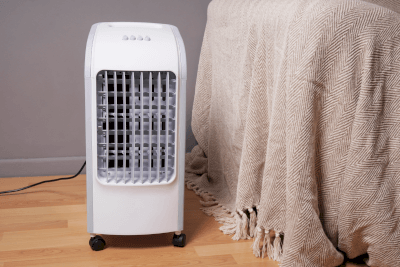What Is a Misting Fan?
 A misting fan combines the functions of a fan and a humidifier. It works by utilizing the heat of vaporization from evaporating water to cool down spaces or objects, potentially lowering temperatures by up to 5 °C. These fans are available in various types, from small tabletop units to portable and large commercial models. They’re often used as humidifiers in dry periods like winter, as the mist they produce evaporates into the air.
A misting fan combines the functions of a fan and a humidifier. It works by utilizing the heat of vaporization from evaporating water to cool down spaces or objects, potentially lowering temperatures by up to 5 °C. These fans are available in various types, from small tabletop units to portable and large commercial models. They’re often used as humidifiers in dry periods like winter, as the mist they produce evaporates into the air.
Uses of Misting Fans
Misting fans serve dual purposes: as cooling fans in hot summer months and as humidifiers during dry seasons. They come in several forms, including small portable models that are battery-operated and safe for children, tabletop versions for personal use, floor-standing models for room cooling and humidification, and large commercial units for factories, workshops, and outdoor events. These larger models help prevent heat stroke and dust in work environments and are also used for humidifying agricultural products. Proper ventilation is crucial when using these fans in large spaces like factories to avoid excessive humidity.
Principle of Misting Fans
1. Ultrasonic Type
Ultrasonic misting fans use sound waves, typically of frequencies several MHz, to generate mist. These high-frequency waves create fine droplets from the surface of the liquid, which are then blown out as humidified air by a blower. When this mist evaporates, it cools the surrounding air by absorbing heat, thereby functioning as a humidifier.
2. Nozzle Spray Type
In commercial applications, nozzle spray types like the one-fluid nozzle and two-fluid nozzle are common. The one-fluid nozzle method sprays high-pressure water through a nozzle to create mist, while the two-fluid nozzle method uses high-pressure air. These methods effectively disperse mist into a space when combined with an electric fan.
Other Information on Misting Fans
1. Placement of Misting Fans
Proper placement of misting fans is essential to prevent condensation, mold, and stains on walls and floors. The optimal location is in the center of the room, away from walls and electrical appliances. Placing the fan about 70 cm above the floor can help minimize floor and ceiling condensation.
2. Precautions When Using a Misting Fan
The quality of water used in misting fans is crucial. Tap water, which contains chlorine, is recommended for its sterilizing properties. To avoid spreading bacteria, avoid using purified, heat-sterilized, or mineral water in these fans.